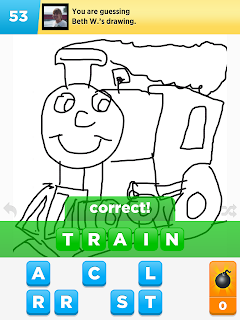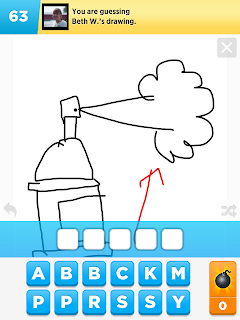"Draw Something" is a great iPad and iPhone app that is essentially a "barrier" game (common therapy structure for communication learning) - I can't see what you have in front of you, and you need to use some form of communication to transmit the idea or concept to me. It's like the board game "Pictionary" in that you have a word that you need to illustrate for the other person to guess. Guessing is supported by having a "closed set" of letters to choose from, as well as blanks that indicate how many letters are in the "mystery word".
Here's an example of a word clue I drew for Adam:
visual clue drawn by me (Sheila B) for Adam
The receptive side of this game (for the person who is the "guesser") works on language skills like word retrieval, word meaning and spelling. If a clue is hard to guess, you can use the "bombs" (lower right) to take away some of the letters that are not in the puzzle (caution! once you run out of these, you have to wait to have enough coins to buy more, so we've learned to use them sparingly). There's also a spot for the person drawing to add comments (which appear after the word is guessed), and I use this to give extra language "context" for the word in the puzzle:
On the expressive side (for the person who is drawing the clue), the game reveals vocabulary knowledge (what do you think the word means?), letting therapists and educators know what gaps to teach to. It also directly practices drawing to communicate - can you draw the meaning of the word clearly enough that another person (at a distance) can understand?
Adam is a natural at this game, and it's provided an interesting way to discover what vocabulary and word information he has learned over the past while. Even though we've known each other for years, I still find myself amazed at the breadth and depth of knowledge revealed through a task like this - often he's just waiting for us to ask the right question in the right way.
His line drawings are full of information and are very clear depictions of the word meanings (and this is not easy to do - when I play this game with my husband, a very smart scientist, I often have to resort to totally random guessing because his drawn clues are ... hmmm, how to put it politely? ... not clear).
Here are some of Adam's drawing clues that he sent to me:
drawn by Adam
drawn by Adam
drawn by Adam
drawn by Adam
drawn by Adam
When you are the person drawing, you have a choice of three words to illustrate. Initially, Adam chose mostly "1 coin" (easier) words, but as he gained confidence, he's tried out some 2 & 3 coin words as well (these words tend to be more conceptual and/or more complex to illustrate).
Here's an example of a clue I drew for Adam for a word that was a non-action verb:
drawn by me
And here's a clue that Adam drew for me for a word that was a concept, using the same idea of drawing a context, then putting in dashes to represent where the word fits:
drawn by Adam
We've also been using this game to highlight special topic vocabulary. For example, since it's the Olympics right now, I chose some "sporting" words on my turns. Here's one that I drew for Adam to guess:
drawn by me
Then Adam chose to give me a sports word on the next turn:
drawn by Adam
This type of drawing exercise helps to build language related to current events in a person's life.
I could easily add in several more pages of drawings, but I'll make myself stop (did I mention that a side benefit for therapist or parent is their own great enjoyment and entertainment? you will treasure the pictures you receive and you will find your own neuroplasticity increasing as you challenge yourself to communicate without verbal language). Well, maybe just a couple more to make my last point (for now) ....
You can use your drawing turns to demonstrate some generally understood visual devices that convey meaning. For example, an arrow indicating which part of your picture illustrates the specific word you are drawing. Here's one of my examples for Adam, drawing the word "voice":
drawn by me
And this is the one that Adam drew for me. Can you guess the puzzle?
drawn by Adam
Have fun, and give the game a try!
** free version is good for a trial, but if you're going to play more frequently, I would suggest purchasing the full app (less than $5, no advertising, be warned that in-app purchases are possible) **














Convert to your idea, iPad developers can focus on drawing section to modify as per your need.
ReplyDeletecomfortable along with beautiful facts thanks intended for placing this kind of pleasant publish
ReplyDeletehttps://itunes.apple.com/us/app/mario-duck-hunt-mario-games/id389205355?mt=8